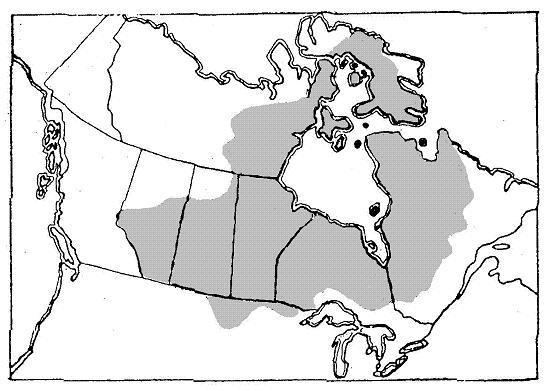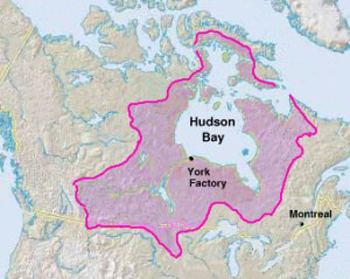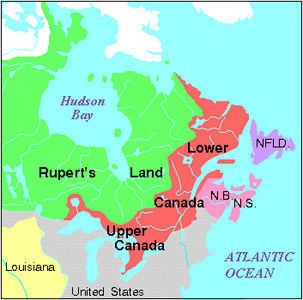Rupert s land
Rupert's Land, or Prince Rupert's Land, was a territory in British North America, consisting of the Hudson Bay drainage basin, which was nominally owned by the Hudson's Bay Company for 200 years from 1670 to 1870, although numerous aboriginal groups lived in the same territory and disputed the sovereignty of the area. The area once known as Rupert's Land is now mainly a part of Canada, but a small portion is now in the United States of America. It was named after Prince Rupert of the Rhine, a nephew of Charles I and the first Governor of the Hudson's Bay Company. In December 1821 the HBC monopoly was extended from Rupert's Land to the Pacific coast.
Contents
- Rupert s land
- Beyond rupert s land
- Hudsons Bay Companys claim of ownership
- Fur trade
- Law
- Missions
- Hudsons Bay Companys surrender of its charter to the Crown
- References

Areas belonging to Rupert's Land were mostly in present-day Canada and included the whole of Manitoba, most of Saskatchewan, southern Alberta, southern Nunavut, and northern parts of Ontario and Quebec. It also included present-day United States territory, including parts of the states of Minnesota and North Dakota and very small parts of Montana and South Dakota. The southern border west of Lake of the Woods to the Rocky Mountains was the drainage divide between the Mississippi and Saskatchewan watersheds until the London Convention of 1818 substituted the 49th Parallel.

Beyond rupert s land
Hudson's Bay Company's claim of ownership

When granted the English Royal Charter in 1670 by King Charles II of England, the Hudson’s Bay Company, under the governorship of the king's cousin Prince Rupert of the Rhine, was granted “the sole Trade and Commerce of all those Seas, Streights, Bays, Rivers, Lakes, Creeks, and Sounds, in whatsoever Latitude they shall be, that lie within the entrance of the Streights commonly called Hudson's Streights, together with all the Lands, Countries and Territories, upon the Coasts and Confines of the Seas, Streights, Bays, Lakes, Rivers, Creeks and Sounds, aforesaid, which are not now actually possessed by any of our Subjects, or by the Subjects of any other Christian Prince or State [sic]”, “and that the said Land be from henceforth reckoned and reputed as one of our Plantations or Colonies in America, called Rupert's Land [sic].” The Royal Charter made the “Governor and Company …, and their Successors, the true and absolute Lords and Proprietors, of the same Territory, Limits and Places aforesaid, and of all other the Premisses [sic],” and granted them the authority “to erect and build such Castles, Fortifications, Forts, Garrisons, Colonies or Plantations, Towns or Villages, in any Parts or Places within the Limits and Bounds granted before in these Presents, unto the said Governor and Company, as they in their Discretion shall think fit and requisite [sic].” Following merger with the North West Company in 1821, the Hudson’s Bay Company’s monopoly privileges and licence were extended to trade over the whole of British North America.
The Rupert's Land Act 1868 of the United Kingdom Parliament authorized the sale of Rupert’s Land to Canada with the understanding that “‘Rupert's Land’ shall include the whole of the Lands and Territories held or claimed to be held by the” Hudson’s Bay Company. The prevailing attitude of the time was that Rupert’s Land was owned by the Hudson’s Bay Company because “From the beginning to the end, the [Hudson’s Bay Company] had always claimed up to the parallel 49,” and argued that the Royal Charter and various Acts of Parliament granted them “all the regions under British dominion watered by streams flowing into Hudson Bay.” Rupert’s Land had been essentially a private continental estate cover 3.9 million km² in the heart of North America that stretched from the Atlantic to the Rocky Mountains, and from the prairies to the Arctic Circle. Even Sir John A. Macdonald saw the land as being sold to Canada: “No explanation has been made of the arrangement by which the country (Rupert’s Land) is handed over to the Queen, and that it is her Majesty who transfers the country to Canada with the same rights to settlers as existed before. All these poor people know is that Canada has bought the Country from the Hudson’s Bay Company, and that they are handed over like a flock of sheep to us.”
However, this did not settle the issue of Aboriginal title over the land. At the time the Royal Charter was granted in 1670, the Crown did not have the authority to give jurisdiction of sovereignty over the territory already settled and inhabited by the Indigenous people of North America. The Royal Charter ignored the First Nations who were already living and having sovereignty to the land, and the Hudson’s Bay Company had not acquired from the Aboriginal communities their title to the land prior to their negotiations with Canada that began in 1856. Due to the Royal Charter and later Rupert's Land Act 1868, the Crown held the attitude that they already possessed the land, and that the treaties were a peaceful way to allow for settlement of the Northwest Territories in lands the Crown already owned. While the First Nations understood the treaties to be between nations to share the land (ownership of the land was not a concept in First Nation’s cultures), the Crown saw them as a way to ensure sovereignty over the land from a people who only had sovereignty as a "personal and usufructuary right, dependent upon the good will of the Sovereign" in the Royal Proclamation of 1763 ("at the time of the discovery of America, and long after, it was an accepted rule that heathen and infidel nations were perpetual enemies, and that the Christian prince or people first discovering and taking possession of the country became its absolute proprietor, and could deal with the lands as such.") The Calder v British Columbia (AG) case in 1973 was the first case in Canadian law that acknowledged "a declaration that the aboriginal title, otherwise known as the Indian title, of the plaintiffs to their ancient tribal territory hereinbefore described, has never been lawfully extinguished." This ruling has led to more Aboriginal land claim negotiations, and overhauled much of the process of addressing Aboriginal title to land that existed prior to colonization and confederation, and whether that title had been extinguished.
Fur trade
In 1670, the Hudson's Bay Company (HBC) was granted a charter by King Charles II, giving it a trading monopoly over the watershed of all rivers and streams flowing into Hudson Bay, an area known as "Rupert's Land" (named in honour of Prince Rupert of the Rhine, the king's cousin and the company's first governor). This covered an area of 3.9 million km2 (1.5 million sq mi), over one-third the area of Canada today.
The Hudson's Bay Company dominated trade in Rupert's Land during the 18th–19th centuries and drew on the local population for many of its employees. This necessarily meant the hiring of many First Nations and Métis workers. Fuchs (2002) discusses the activities of these workers and the changing attitudes that the company had toward them. George Simpson, one of the most noted company administrators, held a particularly dim view of mixed-blood workers and kept them from attaining positions in the company higher than postmaster. Later administrators, such as James Anderson and Donald Ross, sought avenues for the advancement of indigenous employees.
Morton (1962) reviews the pressures at work on that part of Rupert's Land where Winnipeg now stands, a decade before its incorporation into Canada. It was a region completely given over to the fur trade, divided between the Hudson's Bay Company and private traders, with some incursions by the rival North West Company based in Montreal. There was strong business and political agitation in Upper Canada for annexing the territory; in London the Company's trading license was due for review; in St. Paul there was a growing interest in the area as a field for U.S. expansion. The great commercial depression of 1857 dampened most of the outside interests in the territory, which itself remained comparatively prosperous.
Law
Baker (1999) uses the Red River Colony in the "District of Assiniboia" south of Lake Winnipeg, the only non-native settlement on the northwest prairies for most of the 19th century, as a site for critical exploration of the meaning of "law and order" on the Canadian frontier and for an investigation of the sources from which legal history might be rewritten as the history of legal culture. Previous historians have assumed that the Hudson's Bay Company's representatives designed and implemented a local legal system dedicated instrumentally to the protection of the company's fur trade monopoly and, more generally, to strict control of settlement life in the company's interests. But this view is not borne out by archival research. Examination of Assiniboia's juridical institutions in action reveals a history formed less through the imposition of authority from above than by obtaining support from below. Baker shows that the legal history of the Red River Colony – and, by extension, of the Canadian West in general – is based on English common law.
Following the forced merger of the North West Company with the HBC in 1821, British Parliament applied the laws of Upper Canada to Rupert's Land and the Columbia District and gave enforcement power to the HBC. The Hudson's Bay Company maintained peace in Rupert's Land for the benefit of the fur trade; the Plains Indians had achieved a rough balance of power among themselves; the organization of the Métis provided internal security and a degree of external protection. This stable order broke down in the 1860s with the decline of the Hudson's Bay Company, smallpox epidemics and the arrival of trade-whiskey, and the disappearance of the bison. The rule of law was, after the purchase of Rupert's Land by Canada, enforced by the North-West Mounted Police.
Missions
Peake (1989) describes people, places, and activities that were involved in 19th-century Anglican missionary activities in the prairie areas of Rupert's Land, that huge portion of Canada controlled by the Hudson's Bay Company and inhabited by few Europeans. Early in the century, fur trade competition forced the company to expand into this interior region, and some officials saw advantages in allowing missionaries to accompany them. Officially they did not discriminate among denominations, but preference was often granted to the Anglicans of the Britain-based Church Missionary Society. The prairie missions extended from the area of 20th-century Winnipeg to the Mackenzie River delta in the north. Notable missionaries included Revd. John West, the first Protestant missionary to come to the area in 1820, David Anderson the first Bishop of Rupert's Land, the inept William Bompas and the Native American Anglican priests: Henry Budd, James Settee and Robert McDonald.
There were also Roman Catholic missions in Rupert's Land. One notable missionary was Alexandre-Antonin Taché, who both before and after his consecration as bishop worked as a missionary in Saint-Boniface, Île-à-la-Crosse, Fort Chipewyan and Fort Smith.
Hudson's Bay Company's surrender of its charter to the Crown
In 1869–1870, the Hudson's Bay Company surrendered its charter to the British Crown, receiving £300,000 in compensation. While it is often said that Hudson's Bay "sold" Rupert's Land as well as the North-Western Territory, the company had no land to sell: its Charter was essentially for a trading monopoly enforceable on British subjects. Control was originally planned to be transferred on 1 December 1869, but due to the premature action of the new lieutenant governor, William McDougall, the people of Red River formed a provisional government that took control until arrangements could be negotiated by leaders of what is known as the Red River Resistance and the newly formed Government of Canada. As a result of the negotiations, Canada asserted control on 15 July 1870.
However, Canada still did not have legal control because the Imperial Crown had made the transfer subject to treaties being entered into with the indigenous nations. While Canada did pass legislation on 12 May 1870 purporting to create the "Province of Manitoba", the absence of the treaties was soon noted, and it was decided in 1873 to pass a second Manitoba Act which would have legal certainty. Other "numbered treaties" followed, and treaty-making extended to the North-Western Territory, which comprised the regions northwest of Rupert's Land and to the north of the Colony of British Columbia.
The transaction was three-cornered. On November 19, 1869, the company surrendered its charter under its letters patent to the British Crown, which was authorized to accept the surrender by the Rupert's Land Act. By order-in-council dated June 23, 1870, the British government admitted the territory to Canada, under s. 146 of the Constitution Act, 1867, effective July 15, 1870, subject to the making of treaties with the sovereign indigenous nations to provide their consent to the Imperial Crown to exercise its sovereignty pursuant to the limitations and conditions of the Rupert's Land documents and the treaties. Lastly, the Government of Canada compensated the Hudson's Bay Company £300,000 ($1.5 million) for the surrender of its charter on the terms set out in the order-in-council.
The company retained its most successful trading posts and one-twentieth of the lands surveyed for immigration and settlement.
